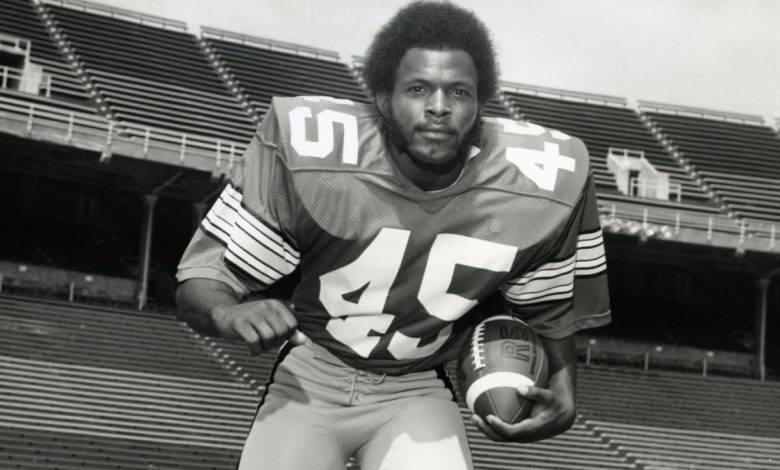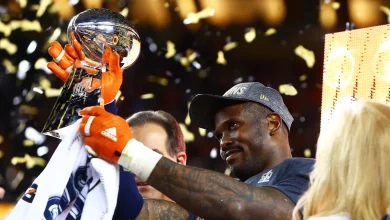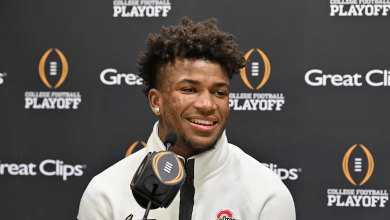Archie Mason Griffin (born 1954) played as running back with the Ohio State Buckeyes American football team. The hard plastic helmet is gray with black, white, and red lines running vertically from the front to the back in the middle of the helmet.

Archie Mason Griffin, born in 1954 in Columbus, Ohio, is one of the most iconic figures in the history of college football. A standout running back for the Ohio State Buckeyes from 1972 to 1975, Griffin’s name is forever etched in the annals of the sport, not just for his extraordinary skill on the field but for his lasting impact on Ohio State University and college football as a whole. A two-time winner of the prestigious Heisman Trophy, Griffin’s career is widely regarded as one of the best in college football history, and his legacy continues to inspire future generations of athletes.
Griffin’s journey to becoming a football legend started early. Growing up in Columbus, he was introduced to the game at a young age. A natural athlete with speed, agility, and vision, Griffin quickly made his mark as a high school football player at Eastmoor High School. By the time he graduated, it was clear that he had the talent to play at the highest level. His success in high school football earned him attention from top college programs across the country, but it was Ohio State that ultimately secured his commitment. Choosing to stay close to home, Griffin became a Buckeye in 1972, setting the stage for what would become an extraordinary collegiate career.
At Ohio State, Griffin found a program that was already well-established under legendary head coach Woody Hayes. Hayes, known for his emphasis on a power-running game, was the perfect coach for a player like Griffin. The hard-nosed, physical style of play that Hayes instilled in his teams fit Griffin’s style to a T. From the moment he stepped on the field as a freshman, it was clear that Griffin had the potential to be something special. Despite being a freshman, Griffin earned a starting role and immediately demonstrated his ability to handle the physical demands of college football. He finished his first season with a solid performance, laying the foundation for the extraordinary years to come.
In his sophomore year, Griffin truly broke onto the national scene. He became a focal point of the Ohio State offense and quickly gained the reputation as one of the best running backs in the country. That year, he rushed for over 1,400 yards and scored 12 touchdowns, helping lead the Buckeyes to a Big Ten Championship and a berth in the Rose Bowl. His performance that season was a preview of the greatness to come, as he consistently demonstrated his unique combination of speed, vision, and toughness. Whether it was breaking through the line of scrimmage or running over defenders, Griffin was an unstoppable force. His ability to make defenders miss with sharp cuts and elusive moves set him apart from other players of his era, and his relentless style of running made him a fan favorite and a nightmare for opposing defenses.
Griffin’s junior season in 1974 was even more impressive. He rushed for over 1,800 yards and 12 touchdowns, helping lead Ohio State to another Big Ten Championship and another Rose Bowl appearance. His dominance on the field did not go unnoticed, and in 1974, he became the first player in college football history to win the Heisman Trophy as a sophomore. Winning the Heisman Trophy was the culmination of an incredible year for Griffin, but it was only a preview of what was to come. By this point, Griffin had cemented his place as one of the greatest running backs in college football history, and his name was being mentioned alongside some of the sport’s all-time greats.
As Griffin entered his senior season in 1975, he was already a household name in college football. Expectations were sky-high, but Griffin was up for the challenge. He continued to dominate on the field, rushing for over 1,900 yards and 12 touchdowns. His senior year was, in many ways, a crowning achievement of his career, as he became the first and only player to win the Heisman Trophy twice. His back-to-back Heisman wins solidified his legacy as one of the greatest college football players of all time, and his career achievements were unparalleled. He finished his time at Ohio State with a remarkable 5,589 rushing yards, a total that would remain a school record for decades.
Griffin’s on-field success was not limited to individual accolades. Under his leadership, Ohio State had great team success, winning three Big Ten titles and appearing in four Rose Bowls during his career. Though the Buckeyes fell short of winning a national championship during Griffin’s tenure, they were consistently one of the best teams in the country, and Griffin’s leadership was a key factor in that success. His presence in the locker room, on the field, and in the community made him an invaluable asset to the team.
Throughout his career, Griffin was known for his toughness, humility, and work ethic. He was the quintessential Woody Hayes player: tough, disciplined, and relentless. Despite his success, Griffin never let fame go to his head. He remained grounded and focused on his team and his goals. His leadership extended beyond the field, as he was highly respected by his teammates and coaches for his character and dedication. He led by example, showing what it meant to be a true student-athlete, balancing his academic responsibilities with his athletic commitments. Even in the face of adversity, Griffin never wavered in his commitment to the team, always putting the success of the Ohio State program above his individual accomplishments.
After his legendary college career, Griffin was selected by the Cincinnati Bengals as the number 24 overall pick in the 1976 NFL Draft. Though his professional career was not as decorated as his college career, Griffin’s impact on the NFL was still significant. He played for the Bengals for eight seasons, from 1976 to 1982, and was known for his hard-running style and consistency. Though he never achieved the same level of success in the NFL as he did in college, Griffin’s professional career was solid, and he earned respect for his durability and leadership. He retired from the NFL after the 1982 season, but his legacy in Ohio and college football remained strong.
Beyond his football career, Griffin became a beloved figure in Ohio State’s history. He remained closely connected to the university after his playing days ended and has remained involved in various philanthropic endeavors. He also became an ambassador for the Ohio State football program, helping to raise the profile of the program and ensuring that the success of the past would continue into the future. He was inducted into the College Football Hall of Fame in 1986, an honor that cemented his place as one of the sport’s all-time greats.
One of the most memorable aspects of Griffin’s career was the helmet he wore while playing for the Ohio State Buckeyes. The hard plastic helmet that he wore was a classic representation of the style of football during that era. The helmet was a simple gray color, but it featured black, white, and red lines running vertically from the front to the back in the middle of the helmet. The design was not overly flashy, but it was instantly recognizable to fans and opponents alike. The helmet became symbolic of Ohio State football during Griffin’s era—a symbol of toughness, discipline, and excellence.
Griffin’s impact on college football extended far beyond his time on the field. He was a role model for countless young athletes who aspired to be like him, and his success helped to elevate the Ohio State football program to new heights. His two Heisman Trophies, his remarkable career rushing totals, and his leadership on and off the field made him a true legend of the game.
Today, Archie Griffin is remembered not only for his Heisman victories but for the mark he left on college football. His legacy as the greatest player in Ohio State history and one of the most accomplished players in college football history continues to endure. His number 45 jersey is a symbol of excellence, and his name will forever be associated with the rich tradition of Ohio State football. As the only player to win the Heisman Trophy twice, Griffin’s place in the pantheon of college football greats is assured, and his impact on the game will never be forgotten.









